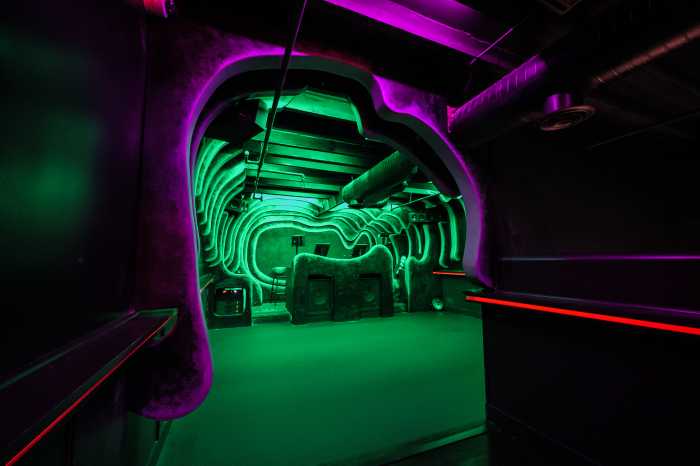Mayor Michael Bloomberg’s announcement last week that the city will
expand the Brooklyn Navy Yard industrial park by 500,000 square feet came
as good news to local manufacturers.
But for Rep. Major Owens and opponents of the plan to build a basketball
arena in Downtown Brooklyn, the expansion announcement was taken as another
slap in the face toward their plan to instead build the future home of
the New Jersey Nets on the Navy Yard’s grounds.
At a meeting with Navy Yard officials just two weeks before the mayor’s
announcement, Owens and members of the anti-arena group Develop-Don’t
Destroy Brooklyn (DDDB) were told that the yard did not have enough space
for developer and Nets owner Bruce Ratner’s planned 19,000-seat arena.
“It seems like all this is just a reaction to our proposal,”
Owens told The Brooklyn Papers, referring to the city’s plan to cull
additional Navy Yard space from the current police department tow pound
on Flushing Avenue and then use that space for commercial and manufacturing
businesses. “They want to step up the propaganda because they just
don’t want Ratner’s arena there.”
In April, Owens teamed up with DDDB and unveiled an alternative to Ratner’s
proposal for an 800,000-square-foot arena, surrounded by office towers,
and planned for the intersection of Flatbush and Atlantic avenues. The
arena, office buildings and 4,500 units of housing are to be designed
by noted architect Frank Gehry and extend for six blocks into Prospect
Heights.
“I think it is possible that an arena could fit on expansion in the
impound lot,” said Daniel Goldstein, a DDDB founding member. “Plus,
there is another 300 acres. We support looking at any possible site for
an arena and that debate should be started, instead of simply going with
the site that Ratner selected.”
Looking at the Navy Yard from the outside, most New Yorkers would assume
it to be nothing more than a vacant lot ravished by thickets of untamed
foliage and years of disrepair. But in the July 1 tour led by representatives
from the Navy Yard’s development corporation, Owens, Goldstein and
The Brooklyn Papers were shown another side of the former military shipyard:
a bustling industrial park, occupied by more than 220 tenants and providing
more than 3,700 jobs for the surrounding community.
Owens was not willing to admit defeat just then. “A large part of
the yard is cluttered with industrial activity in a helter-skelter pattern.
A lot of places can be bulldozed to clear space for new buildings and
business,” he said, citing the new Steiner Film Studios, currently
under-construction in the yards, as a model for development.
The Navy Yard arena plan, submitted as an alternative to that of Ratner,
also includes a new ferry terminal, 25,000 parking spaces, and new, mixed-used
residential and commercial buildings.
“The proposal is about rethinking the way this post-industrial space
is used,” said Jennifer Gellin, one of the architects who helped
develop the alternative proposal. “The idea is to make the waterfront
accessible to the public without disturbing the existing industry.”
Eric Deutsch, president and CEO of the Brooklyn Navy Yard Development
Corporation, seemed baffled by the proposal, remarking that the Navy Yard
did not have space for such an ambitious development.
“This is not a vacant, derelict facility. The buildings that you
see when you drive by are filled to the brim,” Deutsch said, later
adding that small manufacturers occupy nearly 97 percent of the property’s
leaseable space.
“Where would we put [the arena]? Other than a few spaces here and
there, for 300 million square feet, we are pretty much full,” Deutsch
said.
“There is no space, there is not enough mass transit — it is
just not feasible,” he added.
But he made those comments just before the announcement of $71 million
in city funding over the next five years to upgrade streets, sewers and
other elements of the Navy Yard infrastructure.
Starting in 2005, the mayor said, the Navy Yard Industrial Park will grow
by another half a million square feet of new industrial space over three
to five years. That expansion, Bloomberg said, will create 500 to 800
new manufacturing jobs and also develop new retail space along Flushing
Avenue.
“It became clear that the president of the Navy Yard took us on a
tour and only showed us the buildings that were in use and the places
where nothing could be built or are landmarked,” said DDDB’s
Goldstein. “They didn’t show us the vacant lots and buildings.
And then two weeks later they announce an expansion plan where an arena
can feasibly fit. It doesn’t make sense.”
On the tour, Alan Fishman, president and CEO of Independence Community
Bank and chairman of the Navy Yard’s board of directors, also emphasized
the yard’s dry dock facilities as “priceless pieces of infrastructure.”
The alternative arena plan calls for building over part of them.
“There are only a few of them left in the tri-state area,” said
Fishman. Other dry docks, he said, are in Bayonne, N.J., and one at the
old Todd Shipyards in Red Hook’s Erie Basin, which recently closed
to clear land for a planned Ikea store.
“Replacing them would cost billions of dollars,” Fishman said.
Four of the six docks — huge basin-like structures from which water
can be emptied to allow the lower portions of ships to be worked on —
are still in operation, including a 150-year-old granite one that a Navy
Yard official described as being the length of the Empire State Building
if it were laid on its side.
Owens is not the first to eye the Navy Yard as a potential site for development,
nor is he likely to be the last in a long parade of community activists
and city officials who believe that the Navy Yard is the perfect place
to tuck away unwanted public facilities, Deutsch remarked.
“We call it the ‘just put it in the Navy Yard syndrome’,”
said Deutsch, who led Owens on the tour.
“I have had to face a number of people who say, ‘I don’t
want it in my community, just put it in the Navy Yard’,” he
said, referring to attempts to put a waste incinerator, a power plant
and most recently, a facility for the Office of Emergency Management inside
the Navy Yard.
He also noted that for many manufacturers, the Navy Yard stands as a last
refuge for industrial production as many of them have been priced out
of other areas or simply displaced by residential development. With a
proposal to rezone much of Greenpoint and Williamsburg, which would make
close to 300 acres of industrial land available for residential development,
Deutsch said they expect to see many more tenants in the future.
Aside from the dry docks, the Navy Yard houses a number of unique historical
and industrial structures tucked away in its patchwork of aging manufacturing
buildings. The commandant’s house, completed in 1806, is listed on
the National Register of Historic Places.
Land for the shipyard was purchased by the United States Navy in 1801,
and during its early years the Navy Yard built ships to battle Caribbean
and Barbary pirates and outfitted more than 100 ships during the War of
1812. During the Civil War the shipyard was the central base for ship
repair and distributing supplies to the Union fleet.
It continued to thrive during the Spanish-American War, becoming the Navy’s
principal supply depot, as well as during World War I. World War II turned
the Navy Yard into the nation’s largest naval construction facility,
nicknamed the “Can-Do Yard.” Such historic ships as the U.S.
Missouri, upon whose deck the Japanese signed the surrender that ended
the war, were built there.
The city bought the Navy Yard after the federal government closed it in
1966, and turned into an industrial park. A 28-acre parcel known as the
Navy Hospital Annex was set aside from active use, including two buildings
designated as historic landmarks, and a military burial ground.
Two years ago, the annex was turned over to the Navy Yard development
corporation, which has plans to renovate the site.
The newest addition to the Navy Yard is the 15-acre Steiner Studios with
five state-of-the-art film production and sound stages. The first phase
of construction is nearing completion and the studio slated to open this
fall.
Deutsch expects the film studio will provide more than 1,000 jobs and
hopes the company will seek expansion.
“If the studio would like to expand, then the naval annex could serve
as a good site,” he said.

























